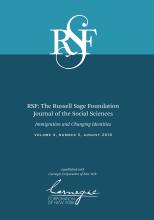Research Article
Open Access
Making Americans: Schooling, Diversity, and Assimilation in the Twenty-First Century
Cristina L. Lash
RSF: The Russell Sage Foundation Journal of the Social Sciences August 2018, 4 (5) 99-117; DOI: https://doi.org/10.7758/RSF.2018.4.5.05
Cristina L. Lash
aDoctoral candidate at the Stanford Graduate School of Education

REFERENCES
- ↵Alba, Richard, and Victor Nee. 2003. Remaking the American Mainstream: Assimilation and Contemporary Immigration. Cambridge, Mass.: Harvard University Press.
- ↵Anderson, Benedict. 1983. Imagined Communities: Reflections on the Origin and Spread of Nationalism. London: Verso.
- ↵
- ↵
- ↵
- Brown, Bryan A.
- ↵
- ↵Charmaz, Kathy. 1995. “Grounded Theory.” In Rethinking Methods in Psychology, edited by Jonathan A. Smith, Rom Harré, and Luk Van Langenhove. London: Sage Publications.
- ↵Chavez, Leo R. 2008. The Latino Threat: Constructing Immigrants, Citizens, and the Nation. Stanford, Calif.: Stanford University Press.
- ↵
- Cheryan, Sapna, and
- Benoît Monin
- ↵Crawford, James. 2000. At War with Diversity: US Language Policy in an Age of Anxiety. Tonawanda, N.Y.: Multilingual Matters.
- ↵Devos, Thierry, Kelly Gavin, and Francisco J. Quintana. 2010. “Say ‘Adios’ to the American Dream? The Interplay Between Ethnic and National Identity Among Latino and Caucasian Americans.” Cultural Diversity & Ethnic Minority Psychology 16(1): 37–49. DOI:10.1037/a0015868.
- ↵Donato, Rubén. 1997. The Other Struggle for Equal Schools: Mexican Americans during the Civil Rights Era. Albany: State University of New York Press.
- ↵Federal Bureau of Investigation. 2016. “Hate Crime Statistics, 2015.” Washington: U.S. Department of Justice. Accessed January 24, 2018. https://ucr.fbi.gov/hate-crime/2015.
- ↵
- Fox, Jon E., and
- Cynthia Miller-Idriss
- ↵Gándara, Patricia. 2013. “Meeting the Needs of Language Minorities.” In Closing the Opportunity Gap: What American Must Do to Give Every Child an Even Chance, edited by Prudence L. Carter and Kevin G. Welner. Oxford: Oxford University Press.
- ↵Gándara, Patricia, and Megan Hopkins, eds. 2010. Forbidden Language: English Learners and Restrictive Language Policies. New York: Teachers College Press.
- ↵Gordon, Milton. 1964. Assimilation in American Life: The Role of Race, Religion and National Origins. Oxford: Oxford University Press.
- ↵Ignatiev, Noel. 1995. How the Irish Became White. New York: Routledge.
- ↵Jiménez, Tomás R. 2017. The Other Side of Assimilation: How Immigrants Are Changing American Life. Berkeley: University of California Press.
- ↵
- Kim, Claire Jean.
- ↵
- Labaree, David F.
- ↵
- Ladson-Billings, Gloria J.
- ↵
- Ladson-Billings, Gloria J
- ↵
- Linton, April.
- ↵
- ↵Lippi-Green, Rosina. 2012. English with an Accent: Language Ideology, and Discrimination in the United States, 2nd ed. New York: Routledge.
- ↵Menchaca, Martha. 1995. The Mexican Outsiders: A Community History of Marginalization and Discrimination in California. AustIn: University of Texas Press.
- ↵Miller, Cassie, and Alexandra Werner-Winslow. 2016. “Ten Days After: Harassment and Intimidation in the Aftermath of the Election.” Montgomery, Al.: Southern Poverty Law Center. Accessed January 24, 2018. https://www.splcenter.org/sites/default/files/com_hate_incidents_report_2017_update.pdf.
- ↵Miller, David. 1995. On Nationality. Oxford: Oxford University Press.
- ↵Oboler, Suzanne. 1997. “‘So Far from God, So Close to the United States’: The Roots of Hispanic Homogenization.” In Challenging Fronteras: Structuring Latina and Latino Lives in the U.S., edited by Mary Romero, Pierrette Hondagneu-Sotelo, and Vilma Ortiz. New York: Routledge.
- ↵
- Ogbu, John U., and
- Herbert D. Simons
- ↵Olsen, Laurie. 1997. Made in America: Immigrant Students in Our Public Schools. New York: The New Press.
- ↵
- Olsen, Laurie
- ↵
- Osterman, Karen F.
- ↵Park, Robert, and Ernest W. Burgess. 1921. “Chapter 11: Assimilation.” In Introduction to the Science of Sociology Including the Original Index to Basic Sociological Concepts, 3rd ed. Chicago: University of Chicago Press.
- ↵
- Perea, Juan F.
- ↵
- ↵
- Portes, Alejandro, and
- Min Zhou
- ↵Roediger, David R. 1991. The Wages of Whiteness: Race and the Making of the American Working Class. New York: Verso.
- ↵Ruggles, Steven, Katie Genadek, Ronald Goeken, Josiah Grover, and Matthew Sobek. 2017. Integrated Public Use Microdata Series: Version 7.0 [dataset]. Minneapolis: University of Minnesota. 10.18128/D010.V7.0.
- ↵
- Sleeter, Christine E.
- ↵Smith, Anthony. 1991. National Identity. London: Penguin Books.
- ↵Smith, Rogers. 1997. Civic Ideals: Conflicting Visions of Citizenship in U.S. History. New Haven, Conn.: Yale University Press.
- ↵Theiss-Morse, Elizabeth. 2009. Who Counts as American? The Boundaries of National Identity. New York: Cambridge University Press.
- ↵Tuan, Mia. 1998. Forever Foreigners or Honorary Whites? The Asian Ethnic Experience Today. New Brunswick, N.J.: Rutgers University Press.
- ↵Tyack, David, ed. 1967. Turning Points in American Educational History. Waltham, Mass.: Blaisdell.
- ↵U.S. Department of Education. 2016. “State of Racial Diversity in the Educator Workforce.” Washington: Government Printing Office. Accessed January 24, 2018. https://www2.ed.gov/rschstat/eval/highered/racial-diversity/state-racial-diversity-workforce.pdf.
- ↵Valenzuela, Angela. 1999. Subtractive Schooling: U.S.-Mexican Youth and the Politics of Caring. Albany: State University of New York Press.
- ↵
- ↵
- ↵
- Yoon, Bogum,
- Anne Simpson, and
- Claudia Haag
- ↵
In this issue
Making Americans: Schooling, Diversity, and Assimilation in the Twenty-First Century
Cristina L. Lash
RSF: The Russell Sage Foundation Journal of the Social Sciences Aug 2018, 4 (5) 99-117; DOI: 10.7758/RSF.2018.4.5.05
Jump to section
- Article
- Abstract
- SCHOOLING, ASSIMILATION, AND NATION-MAKING
- METHODOLOGY
- STAFF DEFINITIONS OF AMERICAN IDENTITY
- FROM THEORY TO PRACTICE: LIMITED ASSIMILATION AT CASTRO
- ASSIMILATION AND STUDENT NATIONAL IDENTIFICATION
- AFRICAN AMERICAN STUDENT PERCEPTIONS OF AMERICANS
- LATINO AND ASIAN–PACIFIC ISLANDER STUDENT PERCEPTIONS OF AMERICANS
- DISCUSSION AND IMPLICATIONS
- FOOTNOTES
- REFERENCES
- Info & Metrics
- References
Related Articles
- No related articles found.
Cited By...
- No citing articles found.





